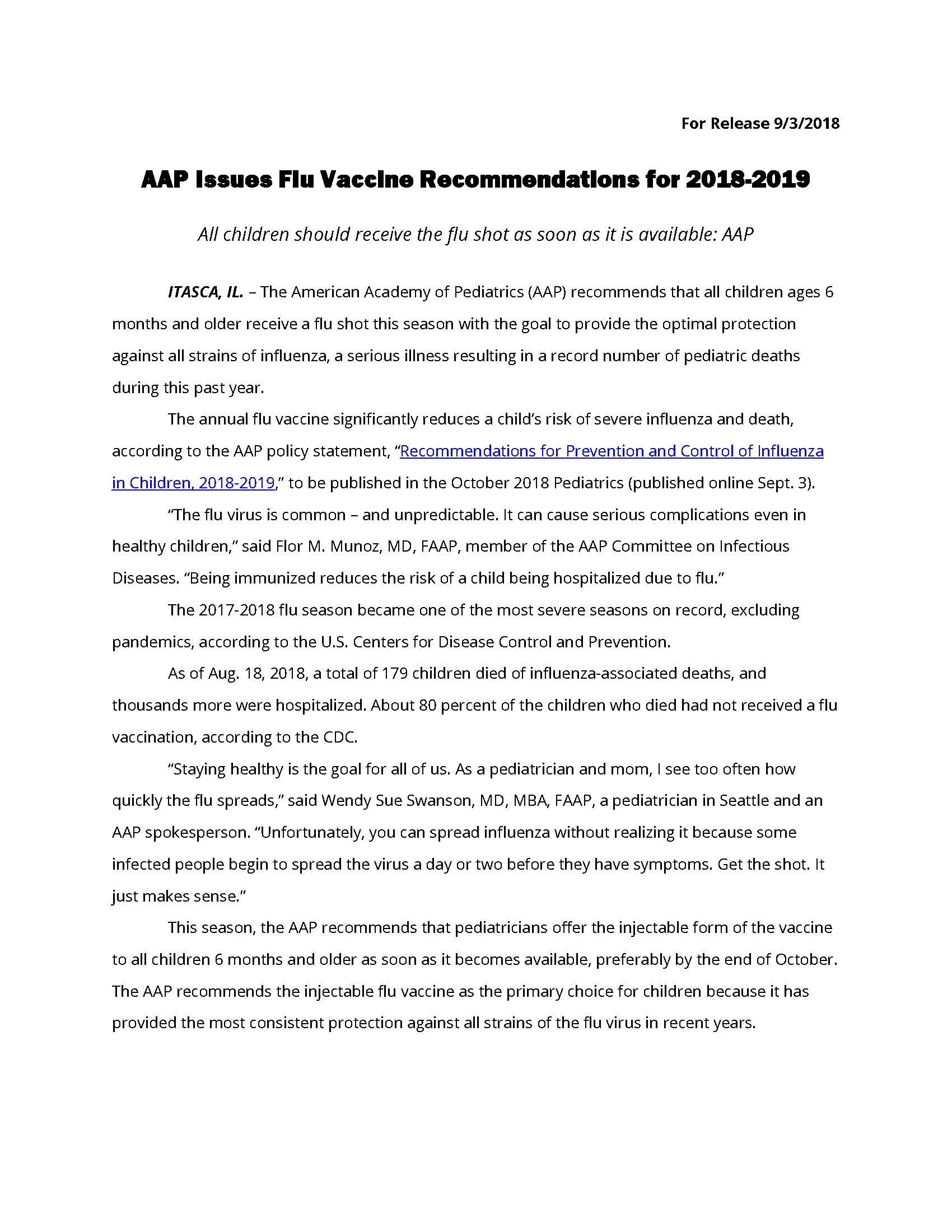All children should receive the flu shot as soon as it is available: AAP
[To download a printable version of this article, click here]
ITASCA, IL. – The American Academy of Pediatrics (AAP) recommends that all children ages 6 months and older receive a flu shot this season with the goal to provide the optimal protection against all strains of influenza, a serious illness resulting in a record number of pediatric deaths during this past year.
The annual flu vaccine significantly reduces a child’s risk of severe influenza and death, according to the AAP policy statement, “Recommendations for Prevention and Control of Influenza in Children, 2018-2019,” to be published in the October 2018 Pediatrics (published online Sept. 3).
“The flu virus is common – and unpredictable. It can cause serious complications even in healthy children,” said Flor M. Munoz, MD, FAAP, member of the AAP Committee on Infectious Diseases. “Being immunized reduces the risk of a child being hospitalized due to flu.”
The 2017-2018 flu season became one of the most severe seasons on record, excluding pandemics, according to the U.S. Centers for Disease Control and Prevention.
As of Aug. 18, 2018, a total of 179 children died of influenza-associated deaths, and thousands more were hospitalized. About 80 percent of the children who died had not received a flu vaccination, according to the CDC.
“Staying healthy is the goal for all of us. As a pediatrician and mom, I see too often how quickly the flu spreads,” said Wendy Sue Swanson, MD, MBA, FAAP, a pediatrician in Seattle and an AAP spokesperson. “Unfortunately, you can spread influenza without realizing it because some infected people begin to spread the virus a day or two before they have symptoms. Get the shot. It just makes sense.”
This season, the AAP recommends that pediatricians offer the injectable form of the vaccine to all children 6 months and older as soon as it becomes available, preferably by the end of October. The AAP recommends the injectable flu vaccine as the primary choice for children because it has provided the most consistent protection against all strains of the flu virus in recent years.
The AAP and CDC also support the use of the nasal spray vaccine – or live attenuated influenza vaccine (LAIV4) – for the 2018-2019 season with the aim of adequate vaccination coverage and optimal protection in children of all ages.
Since the nasal spray did not work as well against influenza A/H1N1 strain during the 2013-2014 and 2015-2016 flu seasons, it was not recommended in the U.S. for the past two flu seasons. Vaccine effectiveness can vary from one flu season to the next. The effectiveness of the latest nasal spray vaccine for this upcoming season is more of an unknown against the influenza A/H1N1 strain.
Therefore, AAP recommends the flu shot as the first choice for children. The nasal spray vaccine may be used this year for children who would not otherwise receive the flu shot, as long as they are 2 years of age or older and healthy without an underlying medical condition. For instance, if a child refuses the flu shot, or if the physician’s office runs out of the injected vaccine, the nasal spray would be appropriate.
The AAP recommendations also include:
- The number of doses of influenza vaccine depends on a child’s age and vaccine history. Children 6 months through 8 years of age need two doses when it is the first time they are being vaccinated against influenza. Children 9 years of age and older require only one dose, regardless of prior vaccination history.
- Children with egg allergy can receive influenza vaccine with no additional precautions than those considered for any vaccine.
- Pregnant women may receive injected influenza vaccine at any time during pregnancy.
- All health care personnel should receive an annual seasonal influenza vaccine, a crucial step in preventing influenza.
- Antiviral medications are important in the treatment and control of influenza, but they are not a substitute for vaccination.
The influenza vaccine is given by injection into the muscle and is inactivated, meaning it does not contain a live flu virus and cannot cause the flu. This season’s flu vaccine has either three (trivalent) or four (quadrivalent) virus strains. Neither vaccine formulation is preferred over the other. Compared with last season’s vaccines, the 2018-2019 vaccines contain one new strain of influenza A (H3N2) and one new strain of influenza B (Victoria lineage).
“The effectiveness of the flu vaccine varies and is affected by factors such as the child’s age, health status, vaccination history and the strain of influenza circulating in a community,” said Henry Bernstein, MD, MHCM, FAAP, a member of the CDC Advisory Committee on Immunization Practices and an Ex-Officio member of the AAP Committee on Infectious Diseases. “We urge parents to talk with their pediatricians now to avoid any delay in getting their children vaccinated.”
Additional Resources include:
- The American Academy of Pediatrics offers a 30-second PSA on preventing influenza in children. Pediatrician Dr. Ilan Shapiro urges parents to get the flu shot for all children ages 6 months and older, every year. He notes that influenza can cause up to 10 days of fever and lead to serious complications, even in health children. The flu vaccine offers the best protection available. The PSA is available for download at https://digitalmedia.vnr1.com/2017/12/01/aap_psas_2018/
- HealthyChildren.org will provide information for parents on preparing for the flu season as well.
###
The American Academy of Pediatrics is an organization of 67,000 primary care pediatricians, pediatric medical subspecialists and pediatric surgical specialists dedicated to the health, safety and well-being of infants, children, adolescents and young adults. For more information, visit www.aap.org and follow us on Twitter @AmerAcadPeds
